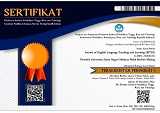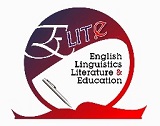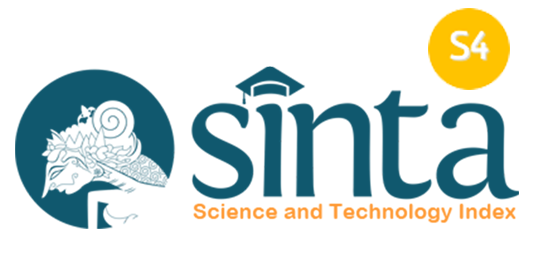EFL students’ challenges in TOEIC® updated test: listening section
Abstract
Keywords
Full Text:
PDFReferences
Basori, B., Mubarok, H., Rohmana, W. I. M., Bisriyah, M., Jayanti, S. D., & Maharany, E. R. (2023). An English placement test at three different periods: the implementation and the test administrators’ views. Journal of English Teaching and Learning Issues, 6(2), 135-152.
Cid, J., Wei, Y., Kim, S., & Hauck, C. (2017). Statistical Analyses for the Updated TOEIC ® Listening and Reading Test (Issue December).
ETS. (2023). About the TOEIC Listening and Reading Test. English Testing Service. https://ets.org/toeic/test-takers/about/listening-reading.html
Gaspar, B., & Hartanto, Y. (2018). the Instrument To Measure English Proficiency of the Prospective Employees: Between Toefl and Toeic. Jurnal Bisnis Terapan, 2(01), 73–80. https://doi.org/10.24123/jbt.v2i01.1088
Harpercollins. (2012). Skills for the TOEIC Test: Listening and Reading. Collins.
Hou, Y. (2024). A Comparison and Evaluation of the TOEIC and DET Writing Test. Journal of Linguistics and Communication Studies, 3(1). https://doi.org/10.56397/JLCS.2024.03.04
Im, G. H., & Cheng, L. (2019). The Test of English for International Communication (TOEIC ® ). Language Testing, 36(2), 315–324. https://doi.org/10.1177/0265532219828252
Jeon, J. (2010). Issues for English tests and assessments: A view from Korea. Language Assessment in Asia: Local, Regional or Global?, 53–76. http://www.asiatefl.org/main/main.php?main=3
Kanzaki, M. (2018). New and Old TOEIC L & R : Score Comparison and Test-Taker Views on Difficulty Level. The 2017 PanSIG J, August, 104–112.
Koryati, Shahab, A., Zulkifli, & Evawati, N. M. (2021). The Correlation Between Students’ Listening Comprehension Strategy and Their TOEIC Score at State Polytechnic of Sriwijaya. Proceedings of the 4th Forum in Research, Science, and Technology (FIRST-T3-20), 1, 41–46. https://doi.org/10.2991/ahsseh.k.210122.008
Nguyen, H., & Gu, Y. (2020). Impact of TOEIC Listening and Reading as a University Exit Test in Vietnam. Language Assessment Quarterly, 17(2), 147–167. https://doi.org/10.1080/15434303.2020.1722672
Nguyen, H. T. N., Phan, T. M. U., Huynh, T. M. D., & Tran, T. K. H. (2020). Difficulties in Studying Toeic Listening Comprehension of Non–English Majored Freshmen At Tay Do University, Vietnam. European Journal of English Language Teaching, 6(1), 16–39. https://doi.org/10.46827/ejel.v6i1.3297
Nicholson, S. J. (2015). Evaluating the TOEIC® in South Korea: Practicality, Reliability and Validity. International Journal of Education, 7(1), 221. https://doi.org/10.5296/ije.v7i1.7148
Prachanant, N. (2012). Needs Analysis on English Language Use in Tourism Industry. Procedia - Social and Behavioral Sciences, 66, 117–125. https://doi.org/10.1016/j.sbspro.2012.11.253
Prasetya, R. E. (2023). Assessing the Impact of English Language Skills and TOEIC Performance on Career Development. Scripta : English Department Journal, 10(2), 281–294. https://doi.org/10.37729/scripta.v10i2.3397
Rido, A. (2020). English for University Graduate Employability: Students and Employers’ Voices. 430(Conaplin 2019), 6–10. https://doi.org/10.2991/assehr.k.200406.002
Schmidgall, J. E. (2017). Articulating and Evaluating Validity Arguments for the TOEIC ® Tests . ETS Research Report Series, 2017(1), 1–9. https://doi.org/10.1002/ets2.12182
Sue, L. I.-W., Cyril J, W., & Wu, J. R. W. (2020). English language proficiency testing in Asia: A new paradigm bridging global and local contexts. Routledge.
Trew, G. (2007). Tactics for TOEIC® Listening and Reading Test. Oxford University Press.
Zahruni, N. A., Fahmi, F., & Pratolo, B. W. (2020). The Challenges of Taking TOEIC Test and How to Overcome: Perception of Indonesian Vocational Students. Ethical Lingua: Journal of Language Teaching and Literature, 7(1), 82–91. https://doi.org/10.30605/25409190.167
DOI: https://doi.org/10.18860/jetle.v5i2.26463
Refbacks
- There are currently no refbacks.
Jalan Gajayana 50 Malang 65144, Jawa Timur, Indonesia

This work is licensed under a Creative Commons Attribution-ShareAlike 4.0 International License.
Indexed by





